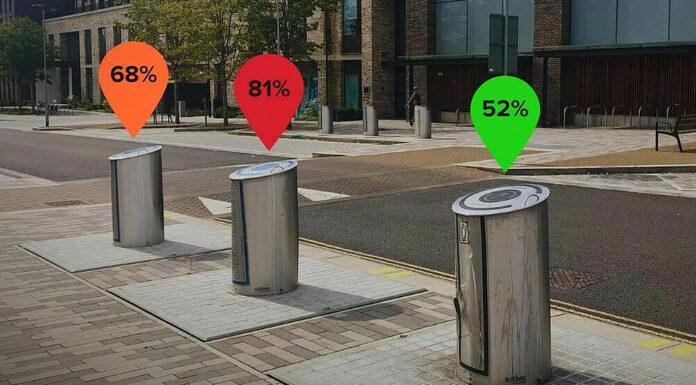UK local councils are grappling with severe financial strains, with projections suggesting that 20 percent could face insolvency by 2025. These councils are challenged to maintain essential services, including waste management, amidst increasingly stringent budgets and regulatory demands. To address these issues, councils must adopt cost-effective solutions that offer the best return on investment for themselves and taxpayers. Gareth Mitchell, UK Partner Manager at Heliot Europe, explores how low-power wide-area (LPWA) IoT solutions can offer a practical and efficient solution for modernising traditional waste management systems, helping local councils to address these issues efficiently and cost effectively.
Local councils across the UK are operating under a cloud of financial uncertainty, with recent reports showing just how real the risk of bankruptcy is. Councils are under intense pressure to spend wisely, as financial difficulties have exacerbated issues such as deteriorating infrastructure, including problems such as potholes.

Among the spending decisions councils have to make is the issue of waste disposal, and how to manage and organise this effectively. The Local Government Association (LGA) highlights that UK councils spend approximately £852 million annually on waste disposal. Many of these contracts are outdated and may not deliver the best value for money. This presents a clear opportunity for councils to enhance cost efficiency and cut budgetary expenditures.
In addition to financial pressures, councils must also navigate rigorous waste management regulations. The Department for Environment, Food & Rural Affairs (DEFRA) plans to introduce ‘Simpler Recycling Laws’ by 2026, targeting reductions in food waste and addressing poor waste management practices. Furthermore, compliance with the EU Waste Framework Directive and the UK Environment Act 2021 is mandatory, with councils required to meet specific recycling and waste reduction targets. Failure to comply, though, can result in substantial fines, increased waste disposal costs, and potential loss of future funding opportunities. This intensifies the financial pressures on councils.
IoT improves operations
Many councils still rely on traditional waste management methods, including manual labour and subcontractors working to fixed collection schedules. This often leads to inefficiencies, such as collecting bins before they are full, wasting resources collecting trash, and driving up operational costs. Additionally, inefficient route planning further adds to expenses and increases landfill taxes, particularly when recycling targets are missed.
Combatting this by integrating IoT sensors into the mix can transform waste management by providing real time monitoring of bin fill-levels. These sensors can alert teams when bins are ready to be emptied or collected, enabling more efficient scheduling, reducing unnecessary pickups. IoT devices are typically designed to operate reliably in various conditions, including adverse weather and low mobile signal areas. When implemented effectively, IoT technology offers the capability to streamline waste management processes, allowing staff to concentrate on more critical tasks, such as maintaining infrastructure elsewhere.
Additionally, incorporating the use of IoT sensors in these situations facilitates compliance with S106 agreements. These often mandate that developers must contribute to local infrastructure improvements, including waste management systems. By improving waste management processes, councils can better allocate resources and improve overall service delivery for citizens and organisations in the wider area within which they operate.
The impact of connectivity
For IoT sensors to be effective, they require reliable connectivity. Low-power wide-area network (LPWAN) connectivity offers significant advantages for waste management operations in this situation. It is cost-efficient and ideal for long-term use. IoT sensors associated with LPWAN infrastructure are compact, affordable, and suitable for widespread deployment across various applications.
A notable example is a recent project at Cambridge University, which demonstrated how LPWAN technology can optimise waste management by providing real-time data and facilitating efficient collection scheduling. Beyond waste management, IoT sensors and LPWAN connectivity can be applied to other municipal functions, such as managing electric vehicle (EV) charging infrastructure. These technologies can monitor usage patterns and manage charging bays, for example, contributing to smarter infrastructure management.
While the broader vision of smart cities is a long-term goal, the immediate benefits of IoT in waste management offers a clear return on investment. Councils can adopt these technologies incrementally, paving the way for future automation without overwhelming existing systems.
Path to sustainable innovation
By embracing IoT and LPWAN technology and connectivity, councils can address today’s current waste management challenges, boost resident satisfaction, and lay the foundation for broader smart city initiatives in the future. This IoT-led approach not only tackles immediate issues that councils face, but it also sets the stage for sustainable growth and innovation in local council operations.
Therefore, for councils funded by taxpayer money, demonstrating the efficient use of resources through tangible initiatives, like smart waste management, is crucial for maintaining public trust and support. In an era where less than 50 percent of the public have confidence in their local councils, attempting to address this ought to be a priority for councils across the country to meet these challenges, both now and into the future.

